A TURKEY TROT THROUGH HISTORY
Published for Explore Saratoga on November 20, 2016.
Planning to burn off some calories during the 15th Annual Christopher Dailey Turkey Trot in Saratoga Springs this year? Don’t forget to check out the scenery while racing your way up North Broadway and back.
474 BROADWAY: CITY HALL
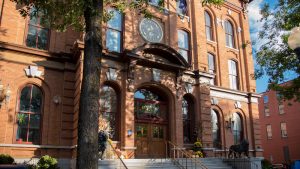
Image Credit: Explore Saratoga
The City of Saratoga Springs was not incorporated until 1915, so what we know as City Hall was originally built as Town Hall in 1871.
This handsome Italianate building was designed by architects Cummings and Burt who were paid a mere $300 for their design. The structure cost $109,999.46 to construct and originally was topped by a bell and clock towers. These were removed in 1936 due to safety reasons. Be sure to wave hello to “Nobility” and “Magnanimity,” the two lion statues next to the front steps.
510 BROADWAY: ALGONQUIN BUILDING
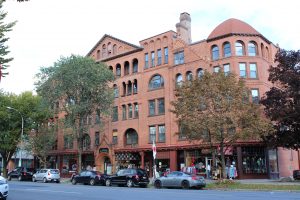
Image Credit: SSPF
We’ve all been watching the multi-million dollar award-winning rehabilitation of the Algonquin this past year, but it was just as costly to build it. According to the Daily Saratogian, the cost to construct the luxury Romanesque influenced apartment building in 1892 was approximately $129,000, a significant amount for the day.
James H. Pardue, an owner of a china, crockery and glassware shop China Hall, hired prominent local architect S. Gifford Slocum to design the building. Known then as the Pardue Building, it was constructed in phases with the center section built first. Pardue resided in the southern portion of the building in an apartment that had ornate woodwork, wainscoting, built-ins and fireplaces – much of which still exists today.
563 NORTH BROADWAY: DR. ADELBERT HEWITT HOUSE
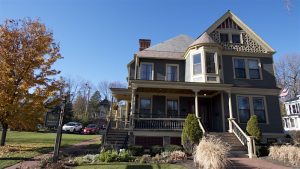
Image Credit: Explore Saratoga
We recognize this beautiful Queen Anne as the office of Witt Construction, but it was originally built in 1884 for well-known physician and surgeon Dr. Adelbert Hewitt, for his home and office.
Later it was home and office of Dr. Arthur Leonard, who in 1952 was serving as the Commissioner of Public Safety and was charged with conspiracy and bribery as part of the Kefauver investigation of illegal gambling in Saratoga Springs. He was believed to be allowing gambling to go on rather than putting an end to it, but the charges were dismissed.
In 1964, the Salvation Army purchased the house and many alterations were made during this time, including the removal of the front porch and cladding it in aluminum siding.
In 1999, John Witt of Witt Construction and Jim Sasko of Teakwood Builders purchased the building and restored it to the original grandeur based on historic photographs.
605 NORTH BROADWAY – SENATOR EDGAR T. BRACKETT HOUSE
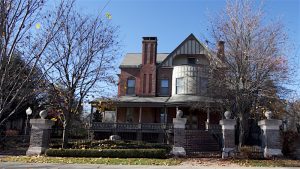
Image Credit: Explore Saratoga
Many of us recognize the name Edgar T. Brackett as the principal founder of the Adirondack Trust Company, but he is also known for being a prominent local attorney, New York State Senator, and for crafting the legislation with Spencer Trask to save Saratoga’s spring waters and creating the Saratoga State Reservation, which is known today as the Spa State Park.
Brackett had this half-timbered with brick Queen Anne home built for him and his family – his two sons, Edgar and Charles. Edgar died at the age of 9 and Charles went to gain fame in film, working with Billy Wilder on 13 films. In addition to receiving an Honorary Academy Award for outstanding service, he won Academy Awards for his screen writing of The Lost Weekend, Sunset Boulevard, and Titanic.
655 NORTH BROADWAY – W. STONE SMITH COTTAGE
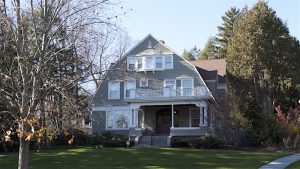
Image Credit: Explore Saratoga
There is a long-standing tradition of homes on North Broadway being used only during the summer. W. Smith Stone, a principal of a well-known stove manufacturer in Troy, built this beautiful Shingle style house to serve as his summer residence.
The house later became the home of John K. Walbridge, the president and manager of The Saratogian. John collapsed at the desk in his office and was brought to the house where he died. Upon his death, the entire first page of the Saratogian was his obituary. Today, you can see the typeset for that edition in Greenridge Cemetery as it was incorporated into his gravestone.
In 1954, the house was turned into five apartments. It was returned to single-family residence in 2008.
658 NORTH BROADWAY – MARY S. WAYLAND HOUSE
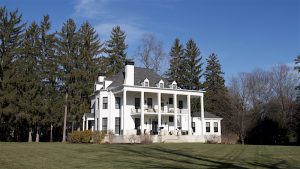
Image Credit: Explore Saratoga
Today we see this graceful white Colonial Revival with double-gallery porches that face the expansive south lawn, but this was not the first house constructed at this site.
In 1876, Mary S. Wayland demolished the original 1856 house and built a new house on the site. A year later she passed away and Eugene O’ Connor acquired the property. In 1888, he hired prominent local architect S. Gifford Slocum to do extensive renovations.
In 1918, the Queen Anne with wrap-around porch was purchased by the Van Duesens. That same year, architect Alfred Hopkins, who also designed the Adirondack Trust Company Bank on Broadway, was hired to transform it into what you see today.
688 NORTH BROADWAY – SOUTHGATE-BRESLIN- GREEN COTTAGE
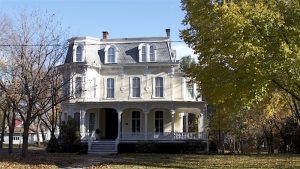
Image Credit: Explore Saratoga
Ever wonder why some houses in Saratoga Springs have a unique looking roof? The character-defining feature of the Second Empire style is the mansard roof, which was named after 17th century French architect, Francois Mansart, and was designed to gain usable attic space.
This beautiful house was built on speculation in 1877 and served as the summer residence for a number of wealthy residents. In 1915, the house became a year-round residence for Colonel Edward Green and his family. The Green family sold the house in 1931 and for periods of time throughout the 1930s and 1940s the house was vacant. In 1946, the house was turned into a boarding house, the Pines Tourist House.
In 1975, it was returned to a single-family residence.
719 NORTH BROADWAY – KING- FULLER-JEFFORDS COTTAGE
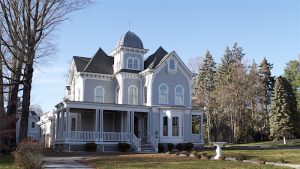
Image Credit: Explore Saratoga
We all know that there is a high price tag for the homes on North Broadway, but this was even true back in 1875 when Dr. Benjamin W. King of Fort Edward built this Italianate style summer residence in 1875 at a reported cost of $30,000, the equivalent of $630,000 today.
In 1882, the King family sold the house to Joseph W. Fuller of Troy who also used it as a summer residence. Fuller was president of the Fuller and Warren stove manufacturing firm, which produced up to 60,000 stoves, ranges, and furnaces annually and had sales buildings in New York, Boston, Baltimore, San Francisco and other cities across the country.
In 1946, Walter and Kay Jeffords, a successful racing family with two Belmont Stakes champions, acquired the house and it served as a summer residence for over 50 years. Ironically, a heating system was never installed in this house since it always served as a summer residence.
740 NORTH BROADWAY – HENRY HATHORN HOUSE
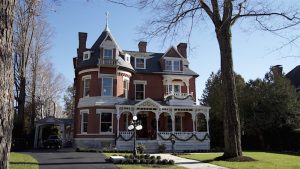
Image Credit: Explore Saratoga
Henry Hathorn, part owner of the United States Hotel, built this handsome Queen Anne in 1884 and was the home of three generations of the Hathorn family, until 1970. At some point the original front porch was removed. This year the current owners restored the beautifully ornate porch based on historic photographs.
Why else do you recognize Hathorn’s name? He sold his interest in the United States Hotel to become part owner of the Congress Hotel, which burned in 1866, the night before opening for the season. While excavating to construct the new hotel the Hathorn Spring was discovered.
791 NORTH BROADWAY – LUCY SKIDMORE SCRIBNER HOUSE
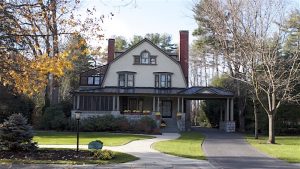
Image Credit: Explore Saratoga
You probably know this home as the official residence of the president of Skidmore College, but that wasn’t always the case. The gambrel roof Queen Anne was purchased in 1897 by Lucy Skidmore Scribner, who was the widow of J. Blair Scribner of the Scribner Publishing Company. In 1903, she founded of the Young Women’s Industrial Club of Saratoga, which was chartered as a four year liberal arts college in 1922.
During her ownership the porte-cochere over the driveway and the upper sun porch, referred to as “the nest” in her diaries, were added. Upon her death in 1931, Skidmore College acquired the house. In 1937, the college exchanged the house for another house closer to the original Union Avenue campus, located at 46 Circular Street. The college reacquired the house in 1964 and in 1987 it became the official residence of the president.
Explore Saratoga is the best way to find Things to Do, Places to Eat and Places to Stay in Saratoga Springs, New York. Find information about events, nightlife, shopping, restaurants, hotels, spas, promotions, etc in Saratoga Springs.
Samantha Bossart is the Executive Director of the Saratoga Springs Preservation Foundation which promotes and preserves the architectural, cultural and landscaped heritage of Saratoga Springs, NY.
